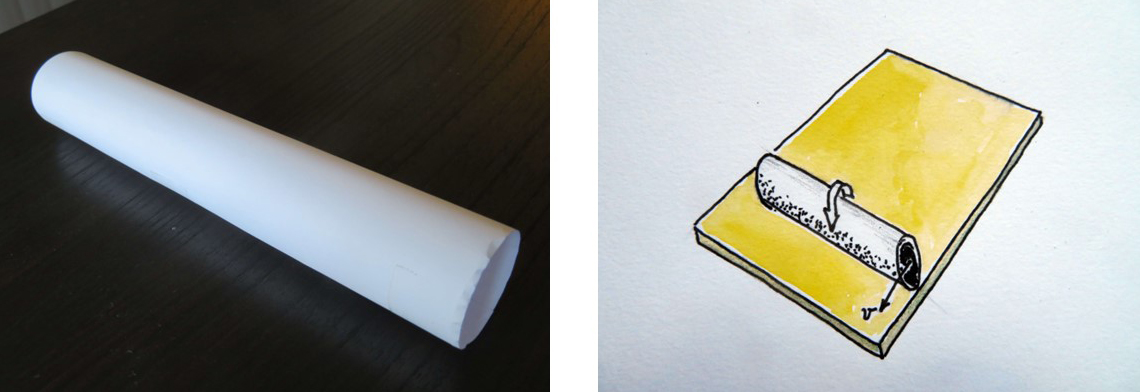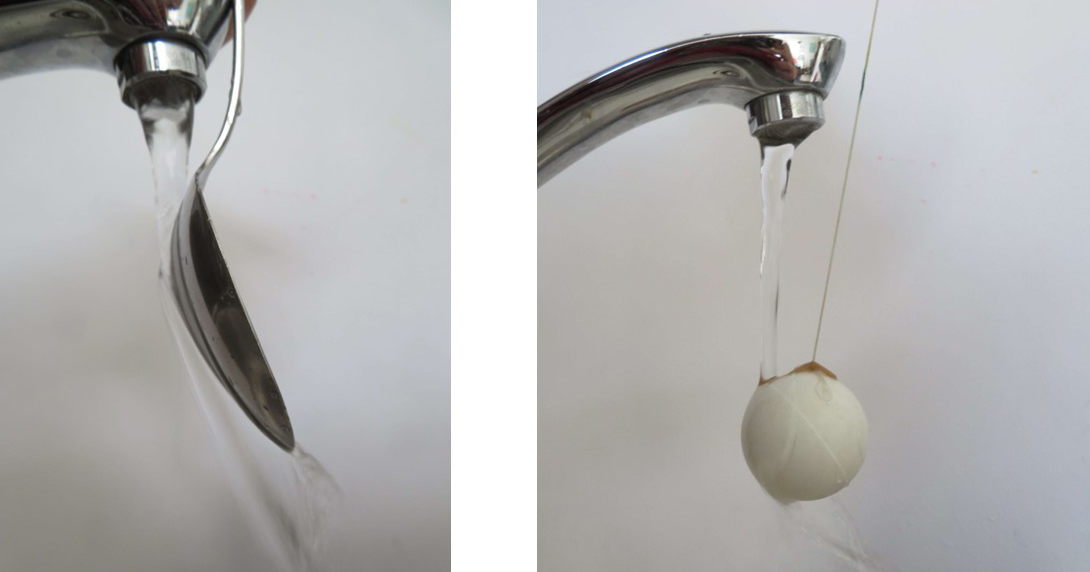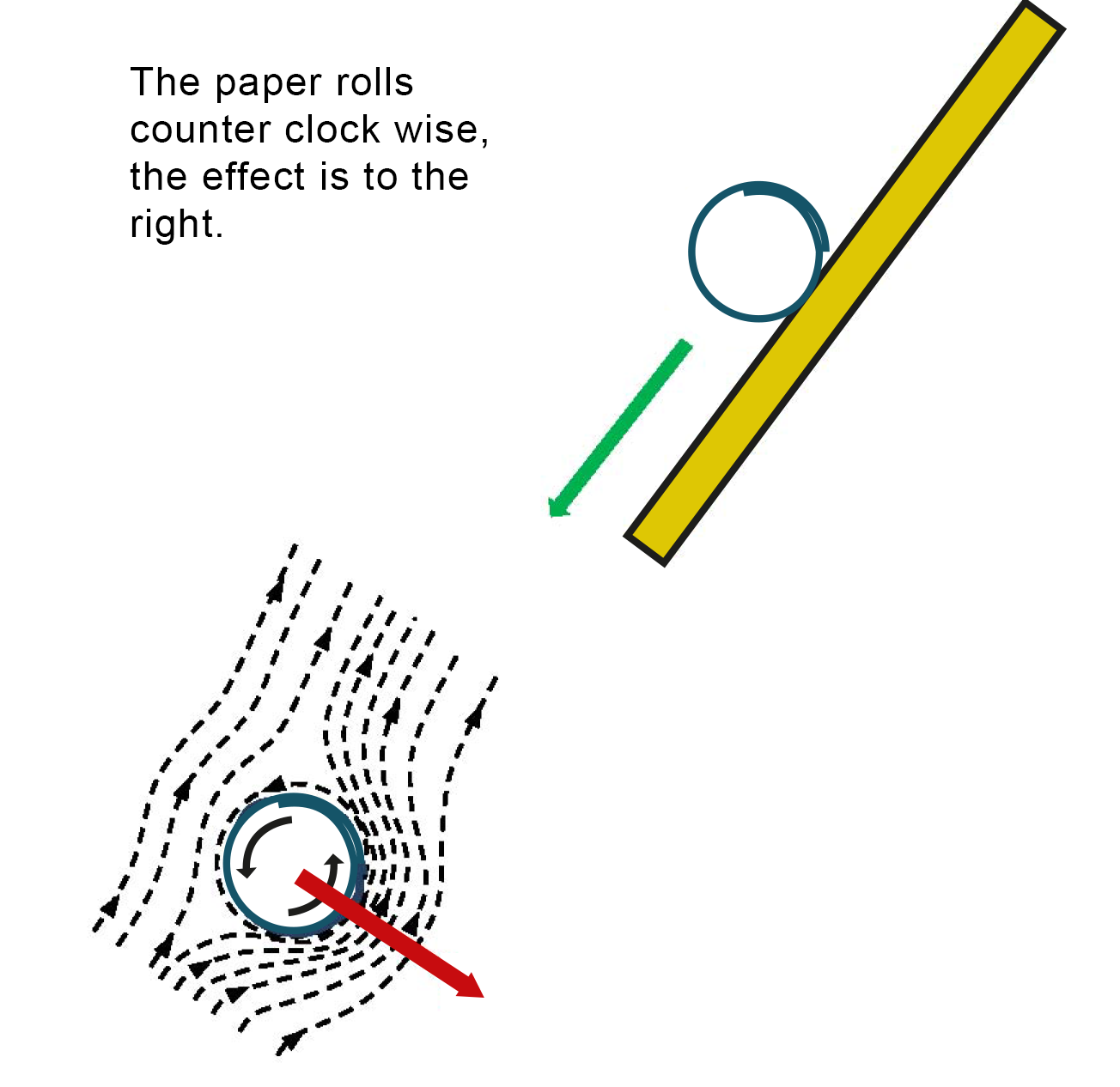19.6. Curve ball#
Coandă Effect
| Author: | Ineke Frederik |
| Time: | 10 minutes |
| Age group: | 12+ |
| Concepts: | Rolling, velocity, Coandă effect, Newton's third law of motion |
Introduction#
You can demonstrate the important concept of a curve ball in sports using simple materials. This experiment provides a qualitative understanding of the Coandă effect. How does it work? It’s a challenge to predict the direction of the curve and to think of possible applications.

Fig. 19.13 A paper tube rolls down a slope.#
Equipment#
A small plank
A ball or marble
A rolled-up sheet of A4 paper
A cardboard tube pierced at 2/3 of its length with some skewers
A light ball that fits loosely inside the tube
A large space (a gym or hallway works well)
For the Coandă effect demonstration:
A faucet
A table tennis ball on a string
A spoon
Preparation#
The light ball should fit inside the tube and have enough friction with the inner surface so that it rolls rather than slides. Practice throwing the ball in a large space. During testing, we found that the best launching method was from a point somewhere on the small platform located 2/3 down the length of the tube, rather than from the very end.
Procedure#
Show what happens when you simply let the ball or marble roll down the plank. Mark the spot where the ball lands. This result will not surprise anyone: the object will follow a roughly parabolic trajectory.
Now let the rolled-up sheet of A4 paper roll down the same plank. It will land in a noticeably different spot! It may seem to curve back towards the plank. The roll experiences a significant force perpendicular to its direction of motion, altering its path.
Now throw the light ball with the tube as far as possible. Give the tube a good spin. The ball will roll along one side of the tube and, spinning, fly out of the end.
You’ll notice that the path has a clear curve. It’s a curve ball!
Possible assignments for students:
Draw the velocity vector at the moment the ball leaves the tube.
Draw how the ball rolls inside the tube during the launch. Determine and sketch how the ball spins at the moment it exits the tube.
Sketch the path you observe the ball taking. Sketch the ball at a point halfway along that path, and add the velocity, spin, and acceleration of the ball.
Can you make the curve go in the opposite direction? How? How can you make it curve upward so it travels further? And how can you make it hit the ground faster?
Name five sports where curve balls are used and explain the purpose of imparting spin in each case.
To conclude, it might be interesting to show the spectacular YouTube video of a basketball being thrown with spin into a canyon.
A bit more explanation can be found in this video.
Physics background#
The observed phenomena can be explained by the Coandă effect []. Flowing water that runs along the convex side of a spoon adheres to the curved surface (Figure 19.14, left). The jet no longer goes straight but is drawn towards the convex surface. Conversely, and according to Newton’s third law, the fluid jet also pulls on the spoon. Flowing water along one side of a table tennis ball follows the curved side of the ball. The water stream bends away from its original direction. According to Newton, the ball is then also pulled into the stream. A table tennis ball on a string will be drawn into a water jet (Figure 19.14, right). Similarly, a table tennis ball can be drawn into an airstream.

Fig. 19.14 The Coandă effect explained using a wat jet.
Left: The water jet bends towards the convex surface.
Right: A ping pong ball is pulled into the water jet.#
The rolled-up A4 paper tube rolls down the plank. It leaves the plank with both velocity and rotation. Because of its speed, the cylinder experiences a kind of counter-wind, just like a cyclist feels the wind in their face when riding fast. The air flowing past is deflected more on the side of the paper cylinder that rotates with the air than on the other side. The air experiences an upward force, and the cylinder experiences an equal and opposite force downward. The cylinder experiences a force perpendicular to the axis of rotation downward. See Figure 19.15. The ball rolling down the slope also experiences this force. However, in comparison to the gravitational force on the rolling object, this force is too small to significantly alter its trajectory.

Fig. 19.15 The paper rotates counterclockwise in its fall, causing the effect to move downwards and to the right.#
The ball you throw with the tube will roll along the inner wall of the tube, gaining both forward speed along the tube’s length and rotational motion. The same effect occurs here. Due to the Coandă effect, the airflow is deflected from its original direction. The effect is strongest where the airflow is fastest. The ball causes the airflow to bend. Conversely, according to Newton’s third law, the ball experiences a force in the direction of the highest airflow speed.
Applications of this effect are found mainly in ball sports. By imparting spin to a ball, you can create curved trajectories. A tennis ball with topspin drops faster, a golf ball with backspin drops slower and travels further, and a soccer corner kick can curl into the goal with the right spin.
Follow-up#
In many sports, there are advanced variations of the simple curve ball, such as the ‘knuckleball’. Students who enjoy a challenge could investigate how a knuckleball is created.
